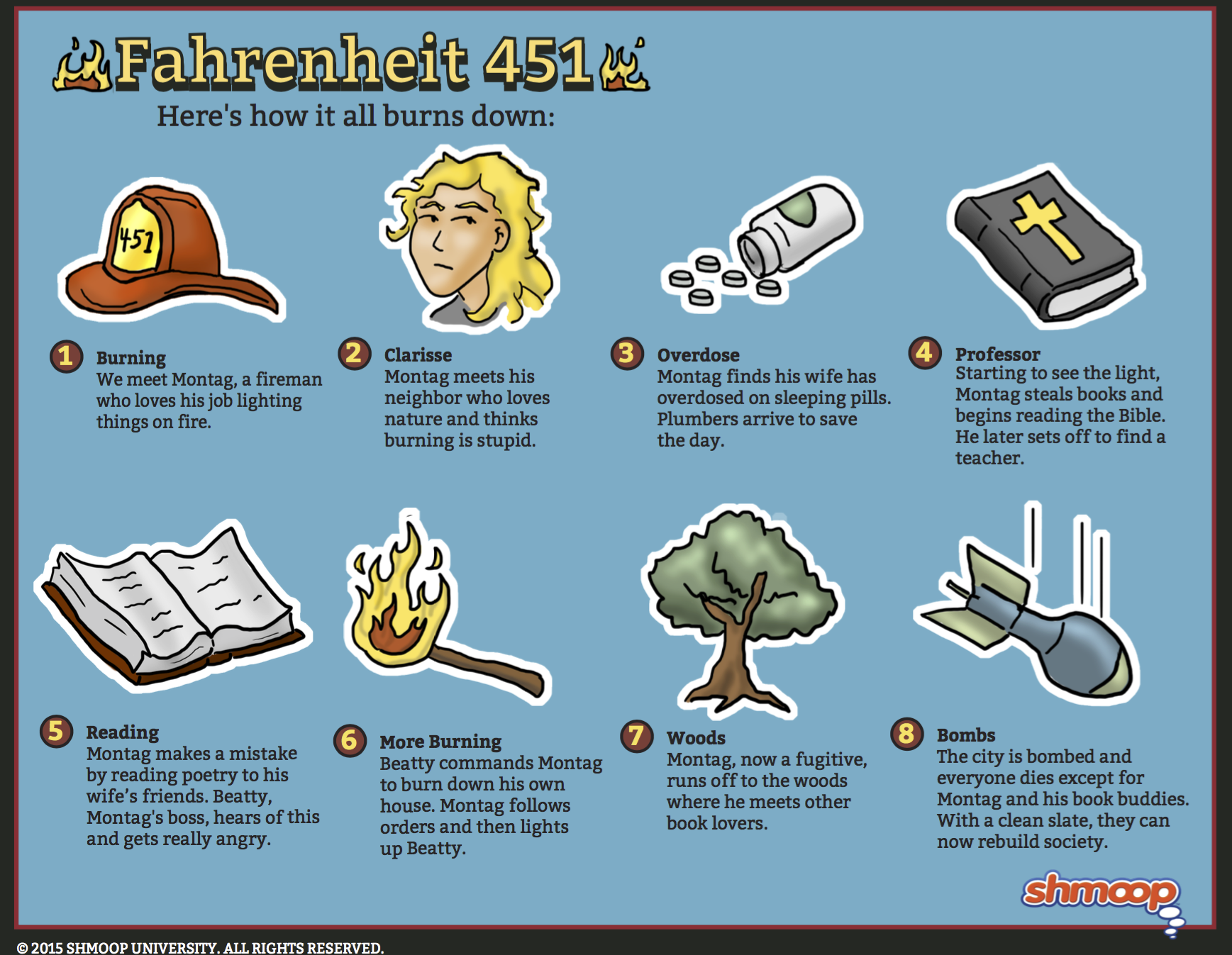Farenhiet 451
Symbols, Themes, Motifs, 5 Stylistic Divices
Fahrenheit 451 by Ray Bradbury, is a novel which through
the protagonist, Guy Montag, represents the
dangers that a divided society can create. In the novel, Bradbury creates a
society in which every single book is forbidden to read, own and all must be
destroyed. The society in the novel says that books are all the source of unhappiness
therefore, they must be destroyed. Guy Montag is a fireman but in that time
firemen instead of putting out fires, they create them to burn all the books in
existence .This a dystopian society because by trying to please everyone, the government
censors what gives the people independence and individuality to limit their
thinking. As the novel continues, we see Montag go through a series of vital
changes, seeing him transform from a mindless drone, happy to do whatever
anyone tells him to, into a free-thinking member of society, forming a
resistance against a government set to destroy all free thought.

5 Stylistic Devices
Allegory:
"...trying to fill a sieve with sand...And the faster he poured, the faster it sifted through with a hot whispering. His hands were tired, the sand was boiling, the sieve was empty" (Bradbury 78).

While on the subway, Montag remembers his childhood memory of himself sitting on a yellow dune and pouring sand through a sieve near the sea. In his memory, the sand represents knowledge and the sieve represents the mind. Bradbury uses the memory of Montag pouring sand through a sieve to say that when knowledge is abruptly poured into the mind, the mind cannot hold the knowledge.

Irony:
Montag is a firefighter that instead of putting out fire, he creates the. That is an irony because is an mixed and opposite sense. “Do you read any of the books you burn?"
Repetition:
Denham's Dentifrice shows repetition because "Den" part appears more that one time, it's consonant sound is used to increase the noise in the society. The noise can be taken as a disruption to the mind. Therefore, the society uses the noise to disrupt people's thinking.

Imagery:
"Now the dry smell of hay, the motion of the waters, made him think of sleeping in fresh hay in a lonely barn away from the loud highways, behind a quiet farmhouse, and under a windmill that whirred..." (Bradbury 142)
This description creates a peaceful, calm image. After the hard of escape from the Hound, Montag is able to imagine and think of a happier place rather than the society.

Metaphor:
"...and his hands were the hands of some amazing conductor playing all the symphonies of blazing and burning..." (Bradbury 3)
Montag is comparing the burning of a fire to a conductor directing a symphony. This shows how Montag loves his job as a fireman. He believes he is doing a good job that helps the world by starting fires and burning books.

Motifs:
Motifs are an object or an idea that repets itself thought the story. It can be seen as an image, sound, action or other figures that have a symbolic significance and contributes toward the development of theme. Some examples are:
Mildred Montag – Guy’s loyalty to the government (The night that Guy meets Clarisse, Mildred attempts suicide; his relationship with Mildred is fine is the beginning but it slowly goes downhill as he moves away from the government)
Fire – Destruction of freedom “Do you read any of the books you burn?’ He laughed. ‘That’s against the law.”

Themes:
The themes are specific words that descibe in one word what the book is about. 451 is a book in which there are some themes that relate to fire such as:
*Burning
*Free Thought
*Books
*Censorship
*Defiance

These are some of the themes of the book. If there is a person who has not read the book and is given these words about it, he or she would have a sence or hint about what the story of the novel is about.
Symbols:
This book in its entirery is symbol and it has many simbolysms hidden inside its lines. Some examples are:
Clarisse McClellan – Uniqueness and free thought ““you think too many things”, said Montag uneasily” (pg.9)
The sieve and the sand – society is speeding up and the people are beginning to forget how to slow down. “his hand were tired, the sand was boiling, and the sieve was empty.” (pg.78)
The White Clown – Conforming to the government’s wishes “They were like a monstrous crystal chandelier tinkling in a thousand chimes” (Pg. 93)

https://prezi.com/gteal4ad2yll/literary-devices-in-fahrenheit-451/
http://f451gns.tripod.com/id3.html
http://www.slideshare.net/guestaa13720a/ray-bradburys-literary-elements